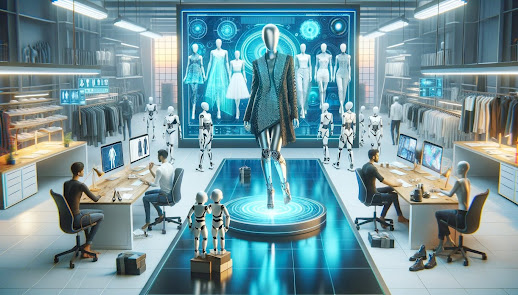Integrating Latest Knowledge, Techniques, Trends, and the Impact of AI
Fashion design, an industry known for its dynamic nature, is experiencing a significant transformation due to technological advancements, particularly in artificial intelligence (AI). This article explores the latest knowledge, techniques, and trends in fashion design, along with the profound impact AI is having on the industry.
Latest Knowledge and Advancements
Sustainable Materials and Practices:
- Eco-Friendly Textiles: The development of sustainable materials like organic cotton, hemp, and recycled polyester is a significant advancement. Innovations in lab-grown leather and bio-fabrics, such as Mycelium (mushroom leather), provide sustainable alternatives to traditional materials.
- Circular Fashion: The shift towards circular fashion emphasizes recycling and upcycling garments, reducing waste, and promoting a more sustainable lifecycle for clothing.
- Digital Innovations:
- Virtual and Augmented Reality (VR/AR): VR is revolutionizing fashion shows, creating immersive experiences for viewers worldwide. AR allows consumers to virtually try on clothes before purchasing, enhancing the online shopping experience.
- 3D Printing: This technology enables the creation of complex designs that are difficult to achieve with traditional methods. 3D printing also allows for rapid prototyping and customization, reducing waste and production time.
Smart Textiles:
- Wearable Technology: Integrating technology into fabrics, smart textiles can monitor health metrics, change color with temperature, or even charge electronic devices. These innovations blend style with functionality, offering new dimensions in fashion.
Techniques
Digital Pattern Making: Computer-Aided Design (CAD) software allows for precise adjustments and easy sharing of patterns, streamlining the design and production process.
Sustainable Dyeing: Techniques such as waterless dyeing and natural dyes reduce the environmental impact of fabric dyeing. These methods minimize water usage and pollution.
Zero-Waste Design: By strategically designing patterns to utilize every piece of fabric, zero-waste design techniques reduce textile waste significantly, promoting sustainable fashion practices.
Trends
Gender-Fluid Fashion: Reflecting a move towards inclusivity, gender-fluid fashion transcends traditional gender norms, focusing on versatility and self-expression.
Minimalism and Timelessness: There is a growing trend towards minimalist designs and timeless pieces that can be worn across seasons. This promotes sustainability by encouraging quality over quantity.
Tech-Infused Fashion: Incorporating technology into clothing, such as LED-embedded garments and responsive fabrics, is gaining popularity. These designs offer unique, interactive experiences.
Cultural Fusion: Designers are increasingly drawing inspiration from diverse cultures, blending traditional elements with modern aesthetics. This trend celebrates global diversity and promotes cultural appreciation.
Impact of AI on Fashion Design
Design and Creativity:
- AI-Assisted Design: AI tools like GANs (Generative Adversarial Networks) can generate new designs by analyzing vast amounts of fashion data. These tools assist designers in creating unique patterns and styles, pushing the boundaries of creativity.
- Trend Prediction: AI algorithms analyze social media, fashion shows, and consumer behavior to predict upcoming trends. This allows designers to stay ahead of the curve and create collections that resonate with current market demands.
Personalization and Customization:
- Personalized Shopping Experiences: AI-driven recommendation systems offer personalized fashion suggestions based on individual preferences and past behaviors, enhancing the shopping experience.
- Custom-Fit Clothing: AI can create custom-fit clothing by analyzing body measurements and preferences, ensuring a perfect fit and increasing customer satisfaction.
Supply Chain Optimization:
- Inventory Management: AI helps optimize inventory levels by predicting demand and reducing overproduction, leading to more sustainable practices.
- Efficient Production: AI-driven automation in manufacturing processes increases efficiency and reduces errors, ensuring high-quality production.
Sustainability:
- Eco-Friendly Design: AI can assist in designing sustainable products by optimizing the use of materials and reducing waste. It can also help in selecting eco-friendly materials based on environmental impact data.
- Waste Reduction: AI algorithms can predict consumer preferences more accurately, reducing overproduction and textile waste.
Conclusion
The fashion design industry is at the cusp of a technological revolution, driven by advancements in AI and sustainability. By embracing new techniques, trends, and AI-driven innovations, fashion designers can create cutting-edge, sustainable collections that meet the demands of modern consumers. The future of fashion lies in the seamless integration of creativity and technology, paving the way for a more inclusive, personalized, and environmentally conscious industry.



.png)



No comments:
Post a Comment